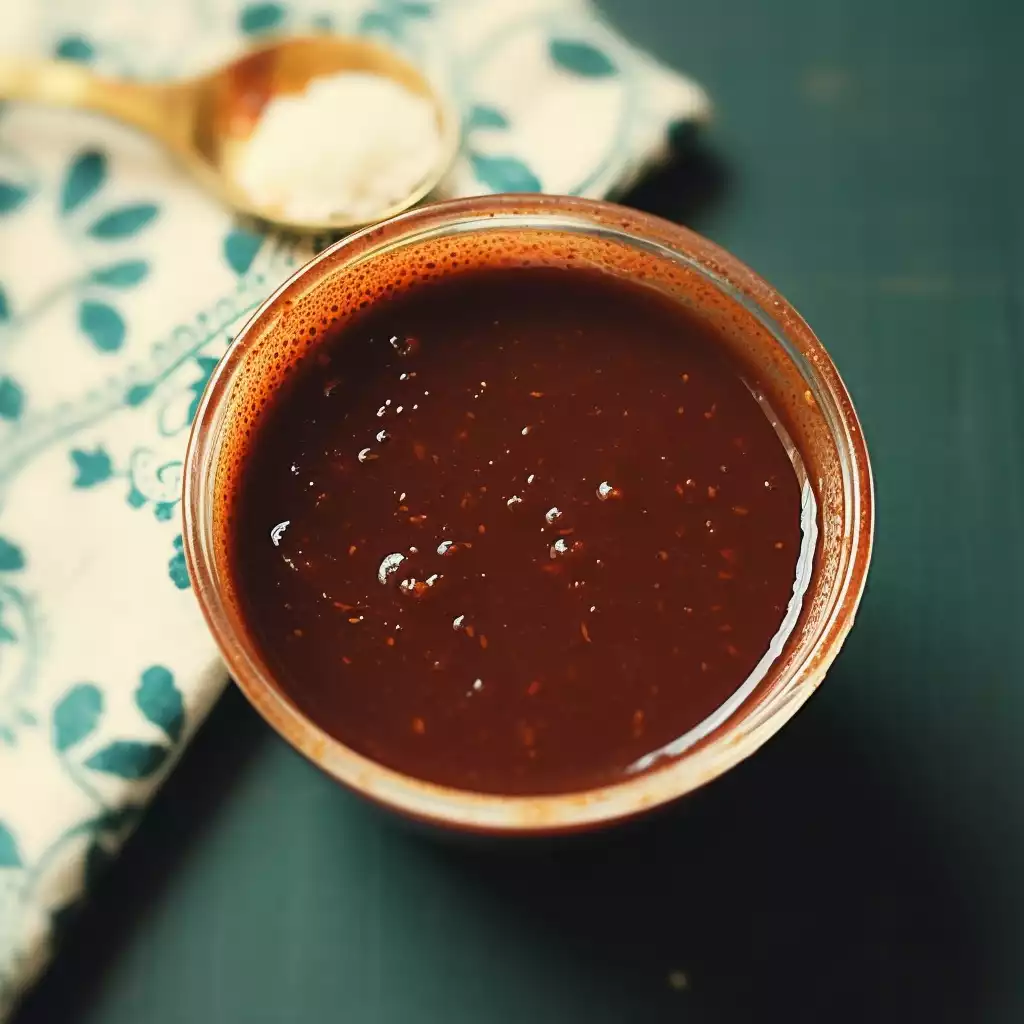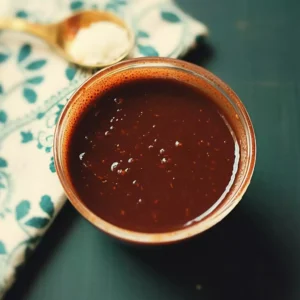
Tamarind Chutney, known for its tangy sweetness, is a popular condiment in many cuisines, especially in Indian cooking.
The origins of this chutney can be traced back to the Indian subcontinent, where tamarind, a key ingredient, has been used for centuries not only for its unique flavour but also for its health benefits. This chutney’s ability to add a sweet and sour zest makes it a staple in many households.
The beauty of Tamarind Chutney lies in its simplicity and the harmony of its ingredients. Made primarily from tamarind pulp, jaggery or brown sugar, and a blend of spices, this chutney is not only delicious but also surprisingly easy to make.
Beginners in the kitchen will find this recipe a good starting point to explore the rich flavours of Indian cuisine.
While the recipe provided is a classic version, Tamarind Chutney is known for its versatility and the different variations it can have. Some versions include dates for added sweetness or mint for a fresh twist. Depending on regional preferences, the spice levels can be adjusted, and additional ingredients like garlic or onion can be included to cater to different palates.
This particular recipe for Tamarind Chutney is straightforward. The process involves simmering and straining tamarind pulp, then combining it with jaggery or brown sugar and a selection of spices like cumin, black salt, red chili powder, ground ginger, cinnamon, and cloves.
The result is a rich, thick sauce that perfectly balances sweet, sour, and spicy flavours.
One of the most appealing aspects of Tamarind Chutney is its flexibility in usage. It can be served as a dipping sauce for snacks like samosas or pakoras, drizzled over chaat (a type of Indian street food), or used as a side to enhance main dishes.
Its sweet and tangy profile also makes it an excellent accompaniment to cheeses and crackers, providing a fusion twist.
For those who love exploring different tastes and textures, Tamarind Chutney is a must-try. It represents a culinary tradition that has been passed down through generations, evolving and adapting but always retaining its core essence – a celebration of the tamarind fruit’s distinctive flavour.
Tamarind Chutney is not just a condiment; it’s a cultural experience. Its preparation is simple yet satisfying, and its versatility in the kitchen makes it a favourite among both novice and experienced cooks.
Whether you’re looking to add a tangy twist to your snacks or seeking to bring a touch of traditional Indian flavour to your meals, this chutney is sure to delight your taste buds and become a cherished addition to your culinary repertoire.
Expert Tip: Adjust the sweetness and tartness to your taste by tweaking the amount of jaggery and tamarind. Remember, it’s easier to add more than to fix an overly sweet or tart chutney.
Tamarind Pulp: Tamarind pulp is essential for its unique sour taste, which is the backbone of this chutney. It offers a distinctive tanginess that’s hard to replicate.
If you can’t find tamarind, a mix of lime juice and a bit of sugar can be a makeshift alternative, but the original flavour of tamarind is irreplaceable. The sourness of tamarind pulp plays a crucial role in balancing the sweetness and spices in the chutney.
Jaggery: This unrefined sugar brings a rich, caramel-like sweetness that complements the sourness of tamarind. If jaggery isn’t available, brown sugar is a good substitute, offering a similar depth of flavour.
Jaggery not only sweetens the chutney but also adds a unique taste that refined sugars can’t match.
Cumin Seeds: Cumin adds a warm, earthy note to the chutney. These seeds are integral in Indian cooking and provide a slight smokiness to the dish. If cumin isn’t your favourite or unavailable, ground coriander could be used, although the flavour profile will change slightly.
Black Salt: Known for its sulphurous, earthy flavour, black salt adds a unique depth to the chutney. It’s different from regular salt due to its distinct taste and aroma. In its absence, Himalayan pink salt or sea salt could be used, but the distinctive flavour of black salt will be missed.
Red Chili Powder: This brings a gentle heat to the chutney, giving it a slight kick. The amount can be adjusted based on your heat preference. Paprika can be used as a substitute for a milder heat and a similar colour.
Ground Ginger: Ground ginger contributes a warm, spicy undertone. It complements the tanginess of tamarind and the sweetness of jaggery. Fresh ginger is an alternative, but it will give a more pronounced ginger flavour.
Ground Cinnamon: Cinnamon adds a sweet and woody flavour, providing a subtle complexity to the chutney. It pairs beautifully with the other spices. If unavailable, a pinch of nutmeg could be used, but it will alter the flavour slightly.
Ground Cloves: Cloves add a pungent, aromatic essence to the chutney. They are strong, so a little goes a long way. If cloves are too intense for your taste, you could reduce the amount or skip them, but they do contribute to the chutney’s unique flavour profile.
Expert Tip: For a smoother chutney, blend the strained tamarind mixture before adding the spices. This step ensures a finer, more consistent texture that’s perfect for dips or spreads.
Yes, Tamarind Chutney stores exceptionally well. If kept in an airtight container in the refrigerator, it can last for several weeks. Its high acidity and sugar content act as natural preservatives. However, always check for signs of spoilage before using.
Absolutely! The spice level in Tamarind Chutney can easily be adjusted to suit your taste. Simply reduce the amount of red chili powder or skip it altogether. The chutney will still have its characteristic tangy and sweet flavours.
Tamarind Chutney is incredibly versatile. Apart from being a dip for snacks, it can be used as a spread in sandwiches, a glaze for grilled meats, or even as a dressing for salads. Its unique flavour can enhance a wide range of dishes.
Yes, tamarind concentrate can be used as a substitute for tamarind pulp. However, since it’s more concentrated, you’ll need to use it sparingly and adjust the amount to achieve the desired taste and consistency.
If your chutney is too thick, simply thin it out by adding a little water and cooking it for a few more minutes. Conversely, if it’s too thin, allow it to simmer for a longer period until it reaches the desired consistency. Remember, the chutney will thicken as it cools.
If your Tamarind Chutney tastes bitter, it might be due to overcooked spices or tamarind. To avoid this, ensure that the tamarind and spices are simmered gently and not burnt. Also, the quality of tamarind can affect the taste, so always use fresh, good-quality tamarind.
Yes, you can substitute jaggery with regular white sugar. However, keep in mind that jaggery offers a unique, molasses-like flavour which white sugar lacks. The chutney will still be tasty, but the flavour profile will be slightly different.
Tamarind Chutney is generally suitable for vegetarians and vegans. However, if you have specific dietary concerns, like diabetes, be mindful of the sugar content. For those with allergies, ensure the spices used are safe for your consumption. Always consult with a healthcare provider if unsure.
Expert Tip: Experiment with additional ingredients like dates, raisins, or a pinch of garam masala for a unique twist. These can add depth and complexity to the chutney, giving it a personal touch.
Here are some more recipes for you to enjoy! If you my recipes don’t forget to rate and leave a comment.
If you have any recipe suggestions, please do not hesitate to ask me. A great way to stay in contact with me is through Instagram, Facebook, Twitter and YouTube. Don’t forget to tag me @CookwithNabeela in your recipe photos!

Subscribe now to receive my latest recipes directly in your inbox. Stay up-to-date and never miss out!
Latest comments (2)
Can you freeze this
Absolutely! Freezing this chutney should work well. Just ensure you store it in a freezer-safe container, and it should last for a few months.